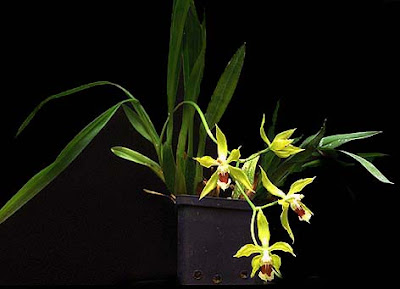Odontoglossum subuligerum is found in Peru and Bolivia, where it grows epiphytic on trees at an altitude of about 2500 meters above sea level...
Odontoglossum subuligerum also called as The Terete-Leafed Odontoglossum, Oncidium subuligerum, is a species of the genus Odontoglossum. This species was described by Heinrich Gustav Reichenbach in 1876.
IDENTIFY ODONTOGLOSSUM SUBULIGERUM
Odontoglossum subuligerum is found in Peru and Bolivia, where it grows epiphytic on trees at an altitude of about 2500 meters above sea level.
It is a large sized, cold growing epiphyte with two-leafed, oval, somewhat pointed upward, flattened, growing very tightly to each other, measuring 6 cm in length and 3 cm in width pseudobulb that carry lanceolate, narrow, apically acute, up to 22 cm in length and 2.5-3 cm in width leaves.
The Terete-Leafed Odontoglossum blooms in the fall on an axillary, to more than 35 cm long, 2 to 3 flowered, racemose inflorescence with the flowers held in a short raceme at the apex of the inflorescence and has 4 or more, short, widely spaced, close, tubular sheaths. The flowers are yellow, in the shape of an asterisk, about 6.5 cm in diameter, intensively covered with chestnut-brown spots, and have a protective skin (1.5 cm long). The upper sepals is lanceolate, with a pointed tip, measuring 3.3 cm in length and 1 cm in width. Lateral sepals some already. Petals also with pointed tips, 3 cm in length and 0.8 cm in width. Lip fused with the column, has needle-like growths (about 0.4 cm in length), its anterior part elongated, pointed at the tip, wavy at the edge and covered with a short fringe, a total size of about 2.5 cm long and 0.5 cm wide. The column is white, about 1.4 cm long.
ODONTOGLOSSUM SUBULIGERUM CARE AND CULTURE
Cultural information should only be used as a guide, and should be to be adapted to suit you. Your physical location; where you grow your plants, how much time you have to devote to their care, and many other factors, will need to be taken into account. Only then can you decide on the cultural methods that best suit you and your plants.
Light:
Odontoglossum subuligerum loves the bright sun without access to direct sunlight, so during the hot midday sun on the windows of the southern orientation and the hot evening sun on the western windows, the orchid should be placed behind a curtain (for example, on a table near the window) or in the shade of other plants. Otherwise, the orchid can get sunburn.
Temperature:
This kind of orchid refers to a moderately cold thermal requirements, and throughout the year this orchids are grown under the following conditions: Summer with 18-25 ° C in the daytime and 14-16 ° C at night; Winter with not above 20 ° C in the day and around 12 ° C at night. For the successful cultivation at home, it is necessary that the night temperature of the content is always 4-6 ° C lower than the daytime temperature.
Humidity:
For normal growth and development the plant will be enough 60% in the daytime and 80-90% at night. Especially high humidity is welcomed in the summer. At lower rates, the growth of new shoots is inhibited, and the leaves of the orchid begin to wrinkle and turn yellow.
Substrate, growing media and repotting:
Due of fairly large size, Odontoglossum subuligerum is grown mainly in small narrow pots or hanging wooden baskets. The substrate used must be very breathable, therefore it is recommended to use a mixture of bark of coniferous trees with foam, charcoal and sphagnum moss (no more than 20%). To give the plant stability it is desirable to put pots with orchids in massive clay pots.
Watering:
Watering this kind of orchids directly depends on the total temperature of the content, the higher it is, the more often and abundant it will be necessary to water. When watering orchids in pots, it is necessary to remember that excess water during watering should flow freely out of the pot, as the stagnation of water both inside the pot and in its pallet can very quickly lead to rotting of the roots and the lower part of the plant. The substrate between waterings should dry well, but in no case is more than two days completely dry.
Fertilizer:
During the whole year, this type of orchid is fertilized every 2-3 weeks in the usual fertilizer concentration indicated on the package. In addition to root top dressing, it is also recommended to produce a foliar dressing when the outer part of the plant is sprayed with a very diluted fertilizer. It is best to feed the orchid, alternating both these methods.
Rest period:
Odontoglossum subuligerum does not need a rest period to stimulate flowering. Refusal to flowering orchids can be due to too hot content of the plant, the lack of sufficient differences between night and day temperatures or poor lighting.















COMMENTS